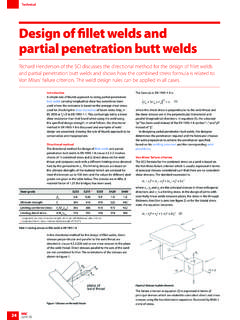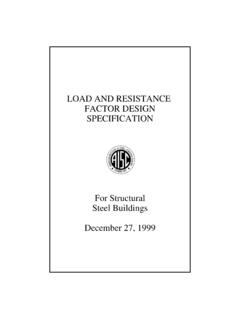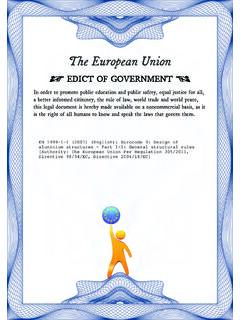Transcription of Lateral torsional buckling and slenderness
1 Technical Lateral torsional buckling and slenderness The expression for slenderness used in the Lateral torsional buckling checks given in BSEN1993-1-1:2005 is different to that given in BS5950-1:2000. Mary Brettle, Senior Engineer at the Steel Construction Institute, examines Lateral torsional buckling and shows how both slenderness expressions are based on the same elastic critical moment theory. 1. WHAT IS Lateral torsional buckling ? flanges. This is why Table 20 of BS5950-1:2000 relates the value Lateral torsional of pb to the ratio of depth / flange thickness (D/T) and Table 7 of buckling may occur in an BS449-2:1969 relates the value of elastic critical stress (Cs) to D/T.
2 Unrestrained beam. A. beam is considered to What affects Lateral torsional buckling be unrestrained when its Some factors that influence the Lateral torsional buckling compression flange is free behaviour of beams are briefly discussed below: to displace laterally and rotate. When an applied Location of the applied load load causes both Lateral The vertical distance between the load application point and displacement and twisting the shear centre of the section affects the susceptibility of the of a member Lateral Figure 1 section to the effects of Lateral torsional buckling .
3 If the load torsional buckling has is applied at a location above the shear centre of a section it is occurred. Figure 1 shows more susceptible to Lateral torsional buckling than if the load was the Lateral displacement and twisting experienced by a beam applied through the shear centre. Applying the load at a location when Lateral torsional buckling occurs. below the shear centre of a section reduces the susceptibility of the section to the effects of Lateral torsional buckling . When What causes the Lateral deflection?
4 The load is applied above the shear centre it is known as a The applied vertical load destabilising load, with loads applied at or below the shear results in compression centre called non-destabilising loads. The effect of a destabilising and tension in the flanges load is considered by the use of effective lengths given in Table of the section. The 13 of BS5950-1:2000, where the effective lengths are longer for compression flange tries destabilising loads compared to the non-destabilising loads. to deflect laterally away from its original position, The shape of the applied bending moment whereas the tension The buckling resistance for a section subject to a uniform flange tries to keep the bending moment distribution along its length is less than the member straight.
5 The buckling resistance obtained for the same section subjected to Lateral movement of a different bending moment distribution. Factors are included the flanges is shown in in design guidance to allow for the effect of different bending Figure 2. moment distributions. UK designers will be familiar with the use The Lateral bending of the equivalent uniform moment factor (mLT) in BS5950-1:2000. Figure 2. of the section creates restoring forces that oppose the movement because the section End support conditions wants to remain straight.
6 These restoring forces are not large The end support conditions considered during the development enough to stop the section from deflecting laterally, but together of the basic theory for buckling moments are equivalent to with the Lateral component of the tensile forces, they determine web cleats that stop the web from deflecting laterally and the buckling resistance of the beam. twisting. For end conditions where more restraint is given to the section the buckling moment increases, with the buckling torsional effect moment decreasing for end supports that offer less restraint In addition to the Lateral movement of the section the to the section.
7 BS5950-1:2000 considers effective lengths when forces within the flanges cause the section to twist about its determining the slenderness of a section to account for the effect longitudinal axis as shown in Figure 3. The twisting is resisted of end restraint on Lateral torsional buckling . by the torsional stiffness of the section. The torsional stiffness of a section is dominated by the flange thickness. That is why 2. SECTION slenderness . a section with The slenderness of a section is used in design checks for Lateral thicker flanges has torsional buckling .
8 The following factors affect the slenderness of a larger bending a section: strength (pb) than Length of the beam the same depth of Figure 3 Lateral bending stiffness of the flanges section with thinner torsional stiffness of the section 30 NSC October 2006. Technical Design codes need to account for the above factors in the guidance they give for determining the slenderness of a section. The elastic critical moment (Mcr) is used as the basis for the methods given in design codes for determining the slenderness BS5400-3:2000.
9 Of a section. The elastic critical moment (Mcr) is similar to the The guidance given in this British Standard for overall Lateral Euler (flexural) buckling of a strut in that it defines a buckling buckling given in clause explicitly uses M cr as follows: load. Euler bucking defines the axial compression that will cause a strut to fail in elastic flexural buckling compared with the elastic critical moment that defines the moment that will result in failure due to elastic Lateral torsional buckling of a beam. The Elastic Where: critical buckling (Mcr) and Euler buckling (PE) curves are shown in Zpe is defined in as Figure 4.
10 The buckling moment of a section 3. EUROCODE 3 DESIGN. is affected by The Lateral torsional buckling design guidance given in plasticity. Therefore BSEN1993-1-1:2005 requires a reduction factor (cLT) to be applied the buckling to the moment resistance of the cross section to give the Lateral moment resistance torsional buckling moment resistance (Mb,Rd). cLT is determined (Mb) cannot be from a factor (FLT) and the non-dimensional slenderness factor greater than the (lLT). The expression given for lLT is: plastic moment (Mpl).





